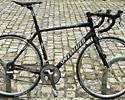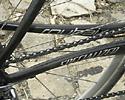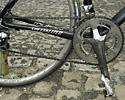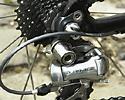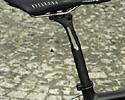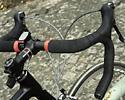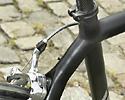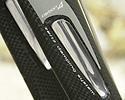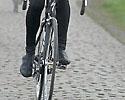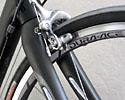
Recently on Cyclingnews.com |
Specialized Roubaix Pro review, August 19, 2004
Specialized has taken a slightly different tack from most builders of high-end bikes with the Roubaix Pro, aiming for a bike that is, yes, light but that's also comfortable thanks to shock-damping inserts and a more relaxed frame geometry. Chris Henry takes one for a spin on the cobbles and finds that...
 |
Comfort breeds performance
What better way to embark upon a bike review than to test the machine on the very turf for which it's named? Such was the occasion when Specialized invited a small flock of journalists to Compiègne, France two days before the 2004 Paris-Roubaix, to test the new Specialized Roubaix Pro road bike. On the menu was about two hours of riding on the Paris-Roubaix parcours, including of course the dreaded Forest of Arenberg. Allez! No wait, that's another Specialized bike... Roubaix!
Philosophy
We'll get to the details of the bike's performance in a bit. First, it's worth discussing the design philosophy behind the Roubaix, which is not exactly your standard racing frame. Far from it. Simply put, the idea behind the Roubaix Pro was to create a bike that offers high performance through improved comfort. With a full carbon frame, and outfitted as this test bike is with Dura-Ace 10 speed components and wheels, this is definitely a performance bike. The difference with respect to traditional racing frames comes in different geometry, and not to mention the use of so-called Zertz inserts for virbations dampening.
"When we first developed the concept of Roubaix, we sought a frame design that was cutting edge on stiffness and weight yet fit riders better and absorbed energy better than existing frames," explained Specialized founder and CEO Mike Sinyard. The Roubaix has been a project near and dear to Sinyard's heart, and both at the pre-Paris-Roubaix test ride and after he was eager to talk about the design differences in the new frame.
"We realized early on that the geometry was one of three key points to achieving the optimal energy absorption," Sinyard continued. "We were confident that our Zertz technology and F.A.C.T. carbon laminate schedule could make for a very comfortable ride; however, our race experience with the Domina Vacanze team had also shown us many of the pro peloton riders use steering geometries that were similar to the Roubaix concept."
That concept is a decreased head tube angle but increased fork offset, designed to keep the trail measurement the same as racing frames like the SWE5 and Tarmac. The result is increased length in the front end (1.5 cm) to improve vertical compliance. The rear of the bike is also lengthened by 1 cm, making for a longer wheelbase and smooth, stable ride.
"For too long, to get maximum speed you had to put up with maximum discomfort," said Sinyard. "What we're after here is a shift in paradigm, that better performance can come out of increased comfort. The result is a bit of a hybrid, like a cross between a Ferrari and a Mercedes."
The Roubaix frame's carbon composition and manufacturing process are also designed to improve ride quality, while at the same time proving very stiff and efficient, not to mention light. The final piece of the puzzle comes from the Zertz inserts, strategically placed viscoelastic vibration dampers in the seat stays, fork and seatpost.
Specialized claims a frame weight of 1,135 grams for a 56cm Roubaix Pro, which according to its own comparisons is heavier than a Giant TCR, but lighter than a its own Tarmac, a Trek Madone, or Time VX. The Roubaix Pro frame is constructed from a one piece front triangle, with the rear stays bonded to the frame and over-wrapped with carbon. The fork and seatpost are both carbon.
First stop: Hell of the North
For our organised ride on the Paris-Roubaix parcours, we drove north from the start town of Compiègne to a non-descript stretch of road just off the autoroute below Denain. The Domina Vacanze team bus was there to waiting for us, with American David Clinger, Russian Alexandre Bazhenov, and Latvian Andris Nauduzs suiting up to join us on our test ride. We were dealt our machines, pedals were installed, seat heights adjusted, and off we went.
With the team car following behind and mechanic on hand, I decided it was best to get some more fine-tuning done before the serious pavé began. I stopped to get a quick raise of the saddle from Domina mechanic Roberto 'Carube' Lencioni and was on my way, but the group wasn't waiting so I had to hasten my warmup on the chilly April day and work on catching the bunch. The first stretch of cobbles came at Heveluy, section 16 on the race route. This was test time for the bike, and as I hit the stones, concentrating as much on my slow start as picking the right line over the uneven pavé, it did begin to occur to me that the bike wasn't rattling my brain like my stiff aluminum model back home.
Riding around the Paris region for the past three years has exposed me to plenty of pavé, and while I'm not exactly the fastest guy over the rough stuff, I at least know what to expect and how to handle the bike. The Roubaix Pro was, despite the de facto adjustment to a completely new frame/setup, quickly proving rather comfortable.
I was basically left to my own devices, getting through the 2.5km section at Haveluy and even getting a bit of a draft from the Domina Vacanze team car on the pavement before the Arenberg Forest. Not being race day, even though the pro teams were out testing their legs and bikes on the course before the main event, the gate marking the entrance to the forest was closed, preventing the full speed dive onto the worst stretch of stones around.
Slowing down enough to give a quick "ciao" to Italian photographer Sirotti, on hand for the pre-race festivities, I got rolling again for the straight 2.4 kilometre slog through Arenberg. Rolling, of course, is a term I use loosely since it's more a matter of staying up and moving in the forest. It's a proven fact that the faster you ride over the cobbles, the easier it gets, and starting from what was essentially zero before the forest didn't make it a pleasant ride. Not that it was supposed to be pleasant, but either way it was a great experience finally riding the course I'd seen so many times on television, complete with a small but hearty bunch of fans along the roadside - out to see professionals riders far more impressive than I.
Having bounced and slid my way across the somewhat soggy forest, and feeling better now that my legs were awake and I had caught my fellow testers, I decided it was time to get serious with the Roubaix Pro. I stuck with the three Domina pros on the pavement before we hit our third section of pavé at Wallers. This was a comparatively tame stretch, but bumpy enough to pay more attention to the bike's handling as I tried to stick to the wheels of Clinger and company.
Wallers and the next section in Hornaing were truly a thrill. Trying to keep the speed high while diving from the middle of the cobbles to the occasional smooth dirt gutter on the right side of the road let me and the bike feel what it was all about. When you put yourself in the Roubaix mindset, not fearing your skinny tires or seemingly delicate race frame, riding the pavé can be as exciting as a fast descent on pavement. Bazhenov and Nauduzs dusted me on the more than 3km stretch at Hornaing, but I did a reasonably good job of limiting the gap and really pushing myself, trying not to worry about the unseen hole that might send me flying. All in all, it was a perfect first test for the bike, and a steady cruise back south to Denain on the road helped let me appreciate the equally nice ride on pavement.
Extended test: 'normal' conditions
I brought the Roubaix back to Paris after the group ride for an extended test, to see how the bike really felt under my normal riding conditions. Already impressed with the handling and particularly the shock absorption of the Zertz inserts on the Paris-Roubaix parcours, I wanted to spend more time with the bike, fine-tune the position, and get to know it on fast road rides in the three to four hour range.
Admittedly, I was rather skeptical about the Zertz concept and how much of a difference some clear elastomer blobs in the frame could make to really damp shock. I'm pleased to report, they live up to the hype. While nothing will save you from the Arenberg Forest, riding on most sections of pavé was a considerably less jarring experience. We're not talking full suspension here; you'll still feel all the bumps. The difference is that the vibrations become more of a series of steady thuds than harsh knocks to the frame/body. The Roubaix Pro feels solid and inspires confidence, rather than giving you the feeling that you're about to have a yard sale from flying bike parts.
What took me longer to adjust to was the different geometry of the Roubaix Pro. The longer wheelbase took me some time to get used to, combined with the more relaxed front end handling. In the first few weeks of riding I kept wondering why Specialized didn't just put the Zertz inserts in a more aggressive racing frame for the ultimate machine. After all, the Roubaix is indeed light and very stiff, and to my mind the marriage of the Zertz and the nice carbon construction with more agile handling and a more compact wheelbase might have been perfect. I asked Sinyard about this, and his response was clear.
"We did not intend for the Roubaix to be Specialized's statement on a carbon fiber race bike," he told me. "We did intend for the Roubaix to be super stiff and very light with the maximum emphasis on comfort."
Fair enough, and now after putting more than 2,000 kilometres on the bike, I think I've come to agree. There was a point at which the bike and I bonded, when I truly started to appreciate its design and stopped worrying that it wasn't what I was used to or what I necessarily thought I wanted. One glorious four hour ride when everything just seemed to click (including my legs, finally), and I was sold.
The Roubaix Pro, despite being named for a flat race with less than perfect road surfaces, is a true performer in a variety of situations. Notably, the bike climbs wonderfully. The stiff, light frame takes nothing away from efforts out of the saddle and I have never felt, whatever the state of my ever-fluctuating fitness, that I was fighting the bike when the going got tough. And, as Sinyard promised, once I adjusted to the bike's handling, it has proven to be an extremely smooth descender as well. I still hit some pavé on almost every ride I take, though not because I necessarily want to, and the 'novelty' of the bike's handling on the cobbles has not worn off. This is good.
Accessories: Some better than others
While professing a strong admiration for the bike as a whole, I will point out some minor issues I have with the bike in its current setup. Specialized has also included its Zertz technology in a set of carbon handlebars, which come in 31.8mm diameter and an multiple-bend ergonomical shape. These bars have a slight wing shape on the tops, though not as flat as carbon bars such as those made by Cinelli. The effect, when combined with Specialized's Body Geometry Bar Phat handlebar wrap, is an incredibly thick handlebar that feels more like holding a baseball bat. The bar tape is nice, but I would prefer a more narrow, round bar on the handlebar tops.
My Roubaix Pro also came with one of Specialized's plastic water bottle cages. While neat looking and for a time quite functional, I've found that the cage didn't stand up to the pounding as well as the frame did. Both of the 'feet' which support the bottom of a water bottle have broken off, no doubt victims of the bottle's bounce over the cobbles. Given how securely the cages hold bottles, this surprises me, but nonetheless I've put some duct tape to use as a temporary fix.
The carbon seatpost, with Zertz insert, has an elegant design and simple but effective fastening mechanism for the saddle. I found out the hard way that the seat post collar is a delicate bird, stripping the threads during a mid-ride adjustment and having to deal with 30 minutes home, out of the saddle. While I have a personal gripe over such critical components being so fragile [I don't believe something that might be adjusted during a ride should require a torque wrench], I actually suspect this seatpost collar was already on its last legs from repeated adjustment on a test bike because it snapped far too easily despite my careful tightening. Specialized promptly send two replacements and I'm happy to say I've not needed the second.
The Specialized stem offers an interesting design, with a sleeve between steerer and clamp that, when rotated 180 degrees, changes the rise of the stem by 8 degrees. This was nice for fine-tuning the bar placement on my test bike, along with the fact that I was able to remove the exceedingly tall (2cm) cone spacer between the FSA headset and the stem. I made my own saddle substitution, sticking to my trusty Fi'zi:k Arione in place of the rather large Body Geometry saddle that came with the bike. The 39x25 gearing was too generous for the Paris riding scene, but again these are all substitutions that are independent of the heart of the bike.
Finally, the Specialized Mondo clinchers have ridden nicely and lasted longer than most on the tough testing in and around urban Paris. Despite accumulating cuts rather easily in the wet, I have not flatted yet with these tires. Which pretty much means I'm due the next time I go riding, having said that, but it was worth noting. I replaced the rear tire with a new model not too long after the test began, as it came with a sizeable gash, but the replacement is holding up well.
Changes for 2005
In fact, Specialized already has some changes in the works for the Roubaix Pro for the 2005. Two sizes have been added to the range: 49cm and 51cm, bringing the total to six available frames. The new FACT carbon monocoque fork will shave roughly 25 grams off the weight of the 2004 model, and S-Works FACT carbon handlebars and stems will be standard equipment in 2005. Specialized's Mindset integrated headset will keep the front end together. Finally, the bike will come equipped with Specialized's Avatar saddle, available in three widths; 130mm, 143mm, and 155mm.
Final verdict: Pleasantly surprised
Ultimately, my verdict on the Roubaix Pro is this: While not a bike I would normally be inclined to try, now that I've had some time to get to know the bike, I have come to fully appreciate its design. The ride quality is superb, and design features that might seem more appropriate for a touring bike are in fact perfectly appropriate for a high performance and race-worthy bike.
Just ask 2004 Peace Race winner Michele Scarponi, who chooses to ride the Roubaix throughout the season and not just in the roughest races. Scarponi even used his Roubaix Pro in the Alpe d'Huez time trial at this year's Tour de France, which is ample justification that the bike is as suited for climbing as it is for tackling tough roads. Comfort breeds performance... Who knew?
Pro: Enhanced comfort with no detectable cost to performance
Con: A couple of niggling component issues
Cyclingnews Rating: ![]()
Full specification: Specialized Roubaix ProFrame:Specialized Roubaix Pro high modulus carbon fiber, 56cm Cranks:Shimano Dura-Ace, 53x39 More information: Specialized's website |
RRP (complete bike): US$3,900Wheels:Shimano Dura-Ace clincher Stem:Specialized Roubaix Pedals: Not included | ||
| |||

